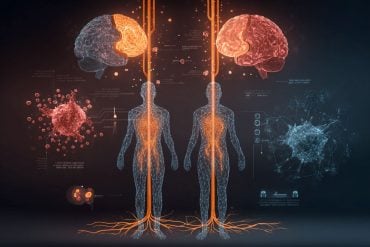Summary: Drumming for 90 minutes per week helps adolescents with ASD to overcome hyperactivity and attention deficits. Learning drumming patterns also tunes brain connectivity in areas associated with inhibitory control and self-regulation.
Source: University of Chichester
Drumming for just 90 minutes each week can improve the life quality of young people diagnosed with autism, a new study has revealed.
Scientists found that learning to play the instrument tuned brain networks in autistic adolescents in as little as eight weeks.
The study was undertaken by experts from the universities of Chichester, King’s College London, Hartpury, and Essex working under their collective group the Clem Burke Drumming Project, named after its co-founding member and famed Blondie musician.
Co-author Marcus Smith, a Professor of Applied Sport and Exercise Science at Chichester, said: “These findings provide direct evidence that learning to drum leads to positive changes in brain function and behavior among autistic adolescents. We are now sharing our results with education providers in special and mainstream UK schools who are responsible for the physical and mental development of vulnerable people.”
Autism is a lifelong neurodevelopmental condition characterized by poor social skills and interactions as well as restricted and repetitive interests and activities.
As part of the study, a group of participants with no drumming experience were given two 45-minute lessons each week across a two-month period. Each volunteer, aged between 16 and 20 years old, undertook a drumming assessment and MRI scan before and after the intervention, while their guardians were asked by the researchers about recent behavioral difficulties.
Results showed that participants who improved their drumming skills showed fewer signs of hyperactivity, inattention and repetitive behaviors and demonstrated better control of their emotions. MRI scans also revealed changes to their brain function which, according to the study, were linked to overall behavior.
Prof Steve Draper, Academic Dean at Hartpury University and report co-author, said the paper represents a landmark moment as the scientific team begins, through advanced imaging, to understand why drumming is such a profound stimulus.
He added: “Over a number of years we have been made aware of cases of drumming benefitting individuals with autism spectrum disorder, or ASD, and have subsequently worked with a number of individuals, schools and projects where we have seen first-hand the effects.”
Researchers leading the study, which was published in PNAS , found that, following drum training, adolescents had improved synchronicity between brain regions responsible for inhibitory control, which prevents impulsivity.

This, according to Reader in Exercise Psychology and co-author Dr Ruth Lowry from the University of Essex, highlights the central role of the prefrontal cortex in regulating motor impulsivity.
She added: “The paper provides us with the first evidence of neurological adaptations from learning to play the drums, specifically for adolescents with an ASD diagnosis. This study endorses the changes we have measured and the observations of teachers and parents towards improvements to social skills, inhibitory control and attention.”
The project, which was funded by the Waterloo Foundation charity, is the latest study by the Clem Burke Drumming Project that has, for the last decade, investigated how drumming can impact brain development.
Renowned imaging scientist Prof Steven Williams from King’s College London, associate of the Clem Burke project, added: “Drumming not only improves the ability to delay the onset of motor responses in autistic adolescents but also reduces hyperactivity and attentional difficulties. Complementary functional imaging allowed us to visualise changes in brain circuits responsible for self-regulation and motor impulsivity.”
Lead author Marie-Stephanie Cahart, a doctoral candidate from King’s College London, said: “This study not only revealed an improvement in behavioural outcomes in autistic adolescents following drum training, but also sheds light on associated changes in brain function. Increased synchronized activity was observed between brain regions that support mental wellbeing and help navigate social relationships.”
Scientists from the Clem Burke Drumming Project will be speaking about the study at a conference on Wednesday 13 July, hosted at the University of Chichester, with free tickets available at thesciencebehindthesticks.eventbrite.co.uk.
The team also intend to expand their drumming research and are looking to collaborate with schools or organisations working with people with ADHD, dyspraxia, dementia, and traumatic brain injury, and can be contacted at clemburkedrummingproject.org.
About this ASD research news
Author: James Haigh
Source: University of Chichester
Contact: James Haigh – University of Chichester
Image: The image is in the public domain
Original Research: Closed access.
“The effect of learning to drum on behavior and brain function in autistic adolescents” by Marcus Smith et al. PNAS
Abstract
The effect of learning to drum on behavior and brain function in autistic adolescents
This current study aimed to investigate the impact of drum training on behavior and brain function in autistic adolescents with no prior drumming experience.
Thirty-six autistic adolescents were recruited and randomly assigned to one of two groups. The drum group received individual drum tuition (two lessons per week over an 8-wk period), while the control group did not.
All participants attended a testing session before and after the 8-wk period. Each session included a drumming assessment, an MRI scan, and a parent completing questionnaires relating to the participants’ behavioral difficulties.
Results showed that improvements in drumming performance were associated with a significant reduction in hyperactivity and inattention difficulties in drummers compared to controls.
The fMRI results demonstrated increased functional connectivity in brain areas responsible for inhibitory control, action outcomes monitoring, and self-regulation. In particular, seed-to-voxel analyses revealed an increased functional connectivity in the right inferior frontal gyrus and the right dorsolateral prefrontal cortex.
A multivariate pattern analysis demonstrated significant changes in the medial frontal cortex, the left and right paracingulate cortex, the subcallosal cortex, the left frontal pole, the caudate, and the left nucleus accumbens. In conclusion, this study investigates the impact of a drum-based intervention on neural and behavioral outcomes in autistic adolescents.
We hope that these findings will inform further research and trials into the potential use of drum-based interventions in benefitting clinical populations with inhibition-related disorders and emotional and behavioral difficulties.







